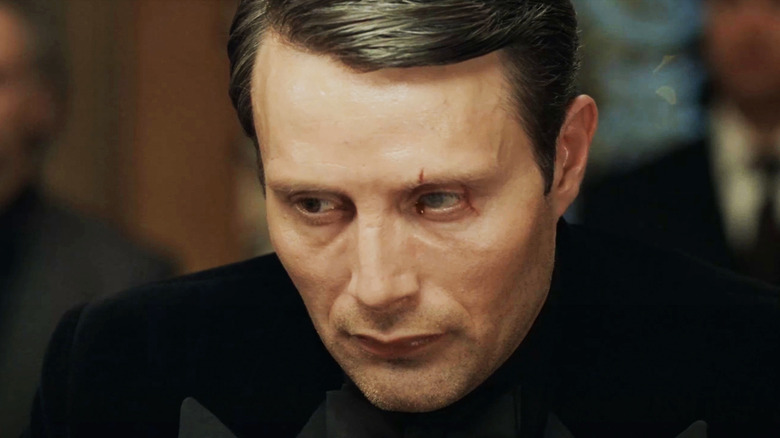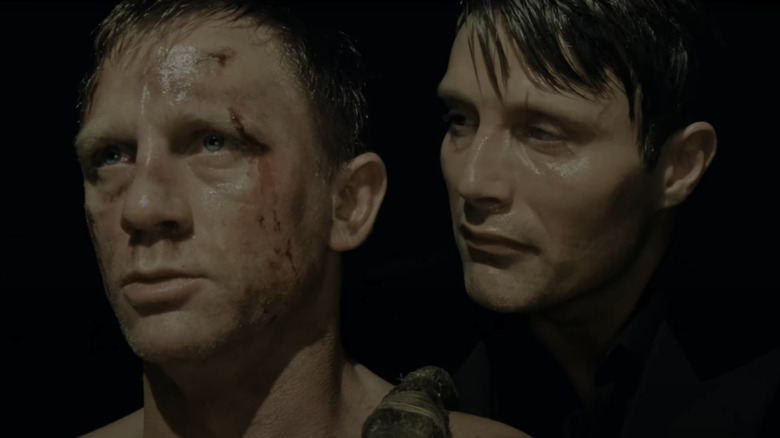Mads Mikkelsen Has His Own Explanation For Le Chiffre's Scar In Casino Royale
2006's "Casino Royale" is the best Bond movie for many reasons. It successfully reinvented 007 for the modern age, delivering not only a great action film but a surprisingly affecting love story, with Eva Green's Vesper Lynd providing a worthy match for Daniel Craig's rugged Bond. But "Royale" is also noteworthy for sticking remarkably close to the source material, i.e. Ian Fleming's 1953 novel of the same name.
The first Bond book in the series, "Royale" was actually the 21st Bond movie, and saw longtime 007 producers Barbara Broccoli and Michael G. Wilson return to the source. Of course, not everything from the novel made it into the film, but for the most part, "Royale" was about as faithful to a Fleming book as a Bond movie had ever been, right down to the antagonist, Le Chiffre, played by Mads Mikkelsen.
In the book, Le Chiffre runs finances for various Soviet projects and activities, but was reimagined for the 2006 movie, becoming a "private banker for the world's terrorists," as Judi Dench's M puts it. In both the novel and the film, however, Le Chiffre lands himself in hot water after losing a sizable amount of his clients' money, forcing him to hold a high-stakes poker game (baccarat in the novel) where he has a chance of winning back the lost cash. One element that definitely wasn't in Fleming's novel, however, was the villain's scarred eye and ability to cry tears of blood. As Le Chiffre says in the film, "Weeping blood comes merely from a derangement of the tear duct ... nothing sinister," all the while conveying about as sinister a tone as possible.
As the eye scarring was a feature added for the movie, Mikkelsen had to get creative when thinking about his character's backstory.
Mikkelsen filled in the gaps himself
In the book version of "Casino Royale," Le Chiffre is somewhat of a mystery, with Ian Fleming declining to give the villain too much of a backstory so as to maintain his overall shadiness. There's certainly no mention of any facial scarring, although Le Chiffre is revealed to have at one point been mute before regaining his speech and becoming the sinister Soviet paymaster he represents in the book.
During the Daniel Craig era of Bond movies, there was all manner of facial scarring, with Javier Bardem's Raoul Silva revealing his deformed visage part-way through "Skyfall" and Christoph Waltz's Ernst Stavro Blofeld becoming scarred after Bond blew up his desert hideaway in "Spectre". Even Rami Malek's Safin, from the divisive "No Time to Die," had significant facial scarring. These days, having disfigured villains in your movie isn't advisable, but when "Casino Royale" was in production, that's exactly what the producers evidently felt they needed.
Unfortunately, without any direction from Fleming's "Casino Royale," and with nothing in the script to explain how Le Chiffre sustained his injury, Mikkelsen didn't have much to go on. In Edward Gross and Mark A. Altman's book, "Nobody Does it Better," the actor explained how he developed his own backstory for Le Chiffre:
"I think he was an orphan from Albania or Algiers — somewhere down there — and he had been a street kid until he turned 14 or 15. I am sure he was small, so he carried a pocket knife, and that eventually ended up in his own eye. That is why that scar is there. He has always had this thing with numbers; he played backgammon, and then he becomes a chess player, and then slightly moves into having contact with the Mob."

